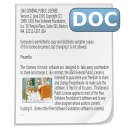Modelo de clasificación de depresión en Tweets usando BERT
Resumen
Hoy en día existen muchos indicios de depresión, así como muchos intentos de suicidio causados por este trastorno emocional, esto se ve reflejado mayormente en redes sociales principalmente en Twitter. Por ello, es importante que los especialistas y organizaciones que busquen salvaguardar la vida de las personas, utilicen herramientas de software que permitan abordar este problema. Para ello, en este trabajo se propone una herramienta web llamada “UBDevs-Depression-Classifier” que permite clasificar y obtener tweets de forma automática por algún tema específico. Se puso un mayor énfasis a tweets relacionados con el COVID-19 debido a que en los años 2020-2021 en el mundo se vivió una pandemia que incrementó los casos de depresión en muchos lugares. Esta propuesta de investigación se centra en la utilización en un modelo basado en NLP (Natural Language Processing) para la clasificación de Tweets con el fin de encontrar aquellos que inciten a la depresión o den a entender que los usuarios se encuentren en un mal estado de ánimo, todo ello con el fin de mantener la salud mental y física de los usuarios de esta plataforma. Existen varios modelos usados como base para proyectos de NLP, sin embargo, en la actualidad BERT ha demostrado ser uno de los más eficientes por ello lo seleccionamos para el desarrollo de nuestra propuesta. Para evaluar la eficiencia del proyecto aplicamos la métrica F1 obteniendo un valor de 0.8806, resultado bastante aceptable respecto a una clasificación textual.
Descargas
Citas
Chen, F., Zheng, D., Liu, J., Gong, Y., Guan, Z., & Lou, D. (2020). Depression and anxiety among adolescents during COVID-19: A cross-sectional study. Brain, behavior, and immunity, 88, 36. DOI: https://doi.org/10.1016/j.bbi.2020.05.061
Islam, M. A., Barna, S. D., Raihan, H., Khan, M. N. A., & Hossain, M. T. (2020). Depression and anxiety among university students during the COVID-19 pandemic in Bangladesh: A web-based cross-sectional survey. PloS one, 15(8), e0238162. DOI: https://doi.org/10.1371/journal.pone.0238162
Lee, S. A., Jobe, M. C., Mathis, A. A., & Gibbons, J. A. (2020). Incremental validity of coronaphobia: Coronavirus anxiety explains depression, generalized anxiety, and death anxiety. Journal of anxiety disorders, 74, 102268. DOI: https://doi.org/10.1016/j.janxdis.2020.102268
Santini, Z. I., Jose, P. E., Cornwell, E. Y., Koyanagi, A., Nielsen, L., Hinrichsen, C., ... & Koushede, V. (2020). Social disconnectedness, perceived isolation, and symptoms of depression and anxiety among older Americans (NSHAP): a longitudinal mediation analysis. The Lancet Public Health, 5(1), e62-e70. DOI: https://doi.org/10.1016/S2468-2667(19)30230-0
Bhuiyan, A. I., Sakib, N., Pakpour, A. H., Griffiths, M. D., & Mamun, M. A. (2020). COVID-19-related suicides in Bangladesh due to lockdown and economic factors: case study evidence from media reports. International Journal of Mental Health and Addiction, 1-6. DOI: https://doi.org/10.1007/s11469-020-00307-y
Reddy MS. Depression - the global crisis. Indian J Psychol Med 2012;34:201-3. DOI: https://doi.org/10.4103/0253-7176.106011
World Health Organization. (2014). Preventing suicide: A global imperative. World Health Organization.
Charoensukmongkol, P. (2018). The impact of social media on social comparison and envy in teenagers: The moderating role of the parent comparing children and in-group competition among friends. Journal of Child and Family Studies, 27(1), 69-79. DOI: https://doi.org/10.1007/s10826-017-0872-8
Anger, I., & Kittl, C. (2011, September). Measuring influence on Twitter. In Proceedings of the 11th international conference on knowledge management and knowledge technologies (pp. 1-4). DOI: https://doi.org/10.1145/2024288.2024326
Sobrino Sande, J. C. (2018) Análisis de sentimientos en Twitter.
Kauffmann, E., Peral, J., Gil, D., Ferrández, A., Sellers, R., & Mora, H. (2020). A framework for big data analytics in commercial social networks: A case study on sentiment analysis and fake review detection for marketing decision-making. Industrial Marketing Management, 90, 523-537. DOI: https://doi.org/10.1016/j.indmarman.2019.08.003
Back, B. H., & Ha, I. K. (2019). Comparison of sentiment analysis from large Twitter datasets by Naïve Bayes and natural language processing methods. Journal of information and communication convergence engineering, 17(4), 239-245.
Leis, A., Ronzano, F., Mayer, M. A., Furlong, L. I., & Sanz, F. (2019). Detecting signs of depression in tweets in Spanish: behavioral and linguistic analysis. Journal of medical Internet research, 21(6), e14199. DOI: https://doi.org/10.2196/14199
Singh, M., Jakhar, A. K., & Pandey, S. (2021). Sentiment analysis on the impact of coronavirus in social life using the BERT model. Social Network Analysis and Mining, 11(1), 1-11. DOI: https://doi.org/10.1007/s13278-021-00737-z
Chiorrini, A., Diamantini, C., Mircoli, A., & Potena, D. (2021). Emotion and sentiment analysis of tweets using BERT. In EDBT/ICDT Workshops.
Pota, M., Ventura, M., Fujita, H., & Esposito, M. (2021). Multilingual evaluation of pre-processing for BERT-based sentiment analysis of tweets. Expert Systems with Applications, 181, 115119. DOI: https://doi.org/10.1016/j.eswa.2021.115119
Qadeer, S., & Wu, D. (2004). KISS: keep it simple and sequential. ACM sigplan notices, 39(6), 14-24. DOI: https://doi.org/10.1145/996893.996845
Rotge, J. F. (2000, September). SGDL-Scheme: a high level algorithmic language for projective solid modeling programming. In Proceedings of the Scheme and Functional Programming 2000 Workshop (Montreal, Canada (pp. 31-34).
Devlin, J., Chang, M. W., Lee, K., & Toutanova, K. (2018). Bert: Pre-training of deep bidirectional transformers for language understanding. arXiv preprint arXiv:1810.04805.
Tan, P., Steinbach, M., and Kumar, V. (2013).Introduction to Data Mining: Pearson NewInternational Edition. Pearson Education Limited.
Virahonda, S. (2021). Depressive and Anxious Tweets. Disponible en: https://www.kaggle.com/datasets/sergiovirahonda/depression-anxiety-tweets
Kazanova, M. (2018). Sentiment140 dataset with 1.6 million tweets. Disponible en: https://www.kaggle.com/datasets/kazanova/sentiment140
Hatzivassiloglou, V., & McKeown, K. R. (1997, July). Predicting the semantic orientation of adjectives. In Proceedings of the 35th annual meeting of the association for computational linguistics and eighth conference of the european chapter of the association for computational linguistics (pp. 174-181). Association for Computational Linguistics DOI: https://doi.org/10.3115/976909.979640
- Conceptualización
- Curación de datos
- Análisis formal
- Investigación
- Metodología
- Software
- Validación
- Visualización
- Redacción - borrador original
- Escritura, revisión y edición
- Conceptualización
- Curación de datos
- Investigación
- Metodología
- Software
- Validación
- Visualización
- Redacción - borrador original
- Conceptualización
- Curación de datos
- Análisis formal
- Investigación
- Metodología
- Software
- Validación
- Visualización
- Redacción - borrador original
- Escritura, revisión y edición
Derechos de autor 2023 Innovación y Software

Esta obra está bajo licencia internacional Creative Commons Reconocimiento 4.0.
Los autores ceden en exclusiva el derecho de publicación de su artículo a la Revista Innovación y Software, que podrá editar o modificar formalmente el texto aprobado para cumplir con las normas editoriales propias y con los estándares gramaticales universales, antes de su publicación; asimismo, nuestra revista podrá traducir los manuscritos aprobados a cuantos idiomas considere necesario y difundirlos en varios países, dándole siempre el reconocimiento público al autor o autores de la investigación.
























